Industries
PLI Scheme: Powering India’s Industrial Renaissance
A Transformational Push for Manufacturing, Employment, and Global Competitiveness
Posted On:
24 AUG 2025 9:55AM
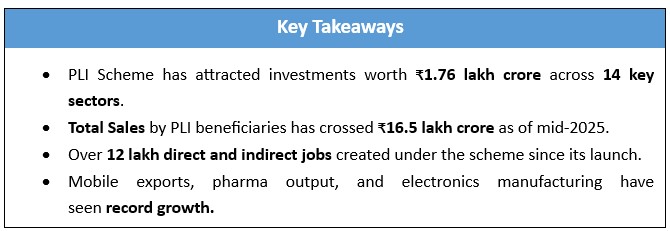
Introduction: A New Chapter in India's Growth Story
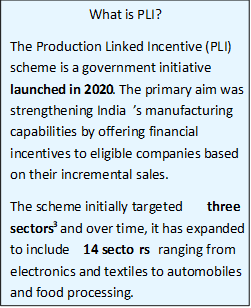
From factory floors to innovation labs, India’s manufacturing sector is undergoing a quiet transformation, one powered by policy intent and industrial ambition. At the heart of this shift is the Production Linked Incentive (PLI) Scheme, which stands as a cornerstone of India’s ambition to raise manufacturing’s contribution to 25% of GDP and claim its place among the world’s leading industrial economies.
With an incentive outlay of ₹1.97 lakh crore, the scheme is more than just a financial package. Today, with 806 applications approved across 14 strategic sectors, the scheme reflects strong industry confidence and robust adoption.
The scheme aligns with national goals like Atmanirbhar Bharat and India’s vision of a $5 trillion economy. It fuels the Make in India movement by reviving domestic manufacturing at scale. It powers Digital India by driving local production of mobile phones, and electronics, making technology more accessible and affordable. And it aligns closely with the India Semiconductor Mission, which, backed by a ₹76,000 crore package, aims to provide financial support for investments in semiconductor fabrication, display manufacturing & chip design to strengthen India's integration into global electronics value chains.
Background: Genesis of the PLI Scheme
India’s services sector has long powered the economy, contributing over 50% to GDP. To create more balanced and resilient growth, the government turned focus to manufacturing: a key driver of jobs, exports, and self-reliance. In 2020, the Production Linked Incentive (PLI) Scheme was launched to boost domestic manufacturing through targeted, performance-based incentives across strategic sectors.
The PLI Scheme was first launched in April 2020, beginning with the Mobile Manufacturing and Specified Electronic Components, Critical Key Starting materials/Drug Intermediaries and Active Pharmaceutical Ingredients and Manufacturing of Medical Devices. Following its initial success, the scheme was progressively extended to cover 13 key sectors of the economy, including pharmaceuticals, automobiles and auto components, Textile Products, white goods, and specialty steel, among others.
Over time, the scheme attracted strong interest from both domestic and global players, leading to approvals of multiple projects in sectors such as electronics, bulk drugs, medical devices, and textiles. For example, in February 2021, the Union Cabinet approved the PLI scheme for the pharmaceuticals sector with an outlay of ₹15,000 crore. Similarly, in September 2021, a ₹25,938 crore PLI scheme for the automobile and auto component industry and PLI scheme for Drones and Drone Components with funding of ₹120 crore for 3 years was cleared.
By November 2024, committed investments under the PLI scheme had reached ₹1.61 lakh crore. This momentum carried into 2025, with realized investments rising to about ₹1.76 lakh crore with 806 approved applications as more projects shifted from approval to active implementation. By focusing on sectors such as electronics, textiles, pharmaceuticals, and automobiles, the initiative links financial incentives to measurable results like increased production and incremental sales. This performance-based model attracts investments from both domestic and global players but also encourages businesses to embrace cutting-edge technologies and achieve economies of scale.
Sectoral Coverage: From Chips to Chemicals
The Production Linked Incentive (PLI) Scheme covers the following 14 critical sectors, with tailor-made incentives and performance frameworks
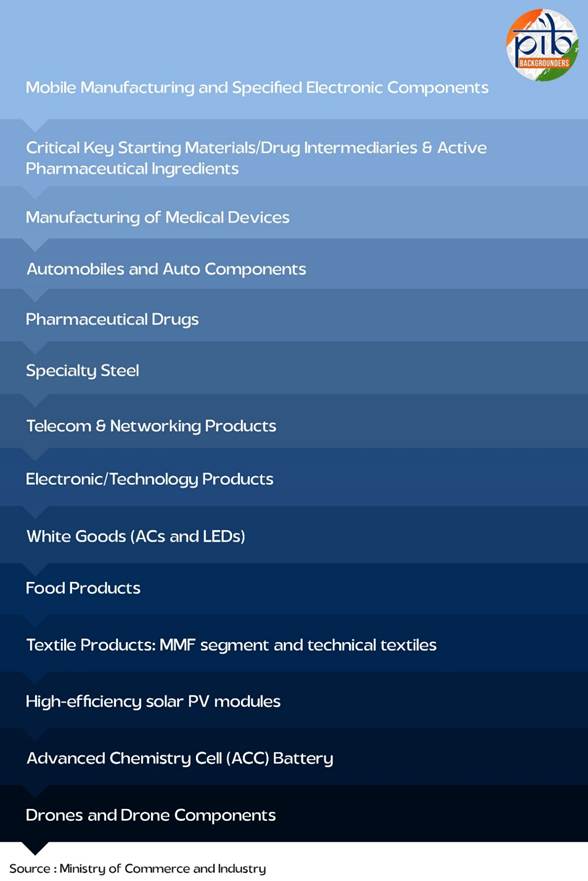
Some of the top Performing Sectors under PLI Scheme include:
Electronics & Mobile Manufacturing
The electronics sector has emerged as a flagship success story under the PLI strategy, driven by strong policy backing through initiatives like the National Policy on Electronics (NPE) 2019. With this policy foundation in place, the PLI attracted both global OEMs and Indian champions, propelling India into the global electronics value chain. The impact has been substantial with production surging by 146%, from ₹2.13 lakh crore in FY 2020-21 to ₹5.25 lakh crore in FY 2024-25. PLI Scheme has encouraged major smartphone companies shifting its production to India. As a result, India has become a major mobile phone manufacturing country.
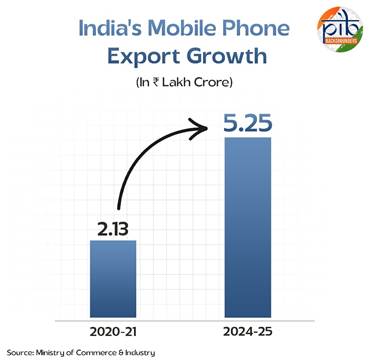
Automobile & Auto Components
Under the PLI scheme, India has attracted committed investments worth ₹67,690 crore. As of March 2024, ₹14,043 crore has been invested, generating over 28,884 jobs. These schemes aim to make India a global EV and clean-tech hub by supporting and driving sustainable mobility aligned with the Faster Adoption and Manufacturing of Electric Vehicles (FAME) initiative. The Scheme proposes financial incentives for 19 categories of Advanced Automotive Technology (AAT) vehicles and 103 categories of AAT components to boost domestic manufacturing of Advanced Automotive Technology products and attract investments in the automotive manufacturing value chain.
With 171 approved applications under the PLI scheme till October 2024, the food processing sector has seen investments of over ₹8,910 crore, with ₹1,084 crore disbursed in incentives. The scheme complements initiatives like PM-Formalization of Micro Food Processing Enterprises (PM-FME) and Pradhan Mantri Kisan SAMPADA Yojana (PMKSY), aiming to modernize processing units, enhance branding of Indian food products, and boost value-added exports.
Pharmaceutical Drugs
Once heavily dependent on imports for essential raw materials, India’s pharma backbone is now regaining its strength. Thanks to focused PLI support, the country transitioned from a net importer (₹1,930 crore deficit in FY 2021-22) to a net exporter of bulk drugs (₹2,280 crore surplus in FY 2024-25). In the first three years, pharma sales under PLI crossed ₹ 2.66 lakh crore, including exports worth ₹ 1.70 lakh crore. The overall Domestic Value Addition in the Sector has been 83.70% as on March 2025.
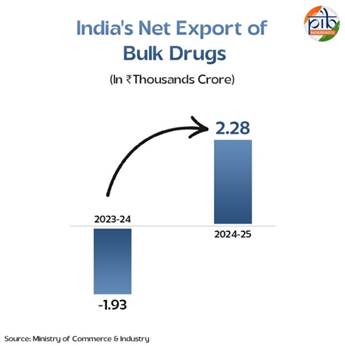
Under the PLI for High-Efficiency Solar PV Modules, PLI Tranche I & II together aim to create nearly 48 GW of fully integrated manufacturing capacity. This is expected to reduce import dependence, strengthen domestic supply chains, and boost India’s energy security under the larger goals of Aatmanirbhar Bharat and the National Solar Mission. Under the PLI scheme for high-efficiency solar PV modules, investments worth ₹48,120 crore have been committed, generating nearly 38,500 direct jobs as of June 30, 2025.
In a world driven by chips, India is scripting its own semiconductor story- bold, strategic, and future-focused. India, with six approved semiconductor projects already in various stages of execution, has now received Union Cabinet approval for four additional manufacturing units in Odisha, Punjab, and Andhra Pradesh. These projects, sanctioned under the India Semiconductor Mission (ISM) with an outlay of ₹4,600 crore, are expected to create direct employment for 2,034 skilled professionals and stimulate the broader electronics manufacturing ecosystem, leading to significant indirect job generation. With a vision to build a self-reliant semiconductor ecosystem by 2030, the government has rolled out dedicated incentives under the India Semiconductor Mission, complementing the broader PLI framework.
The PLI Scheme for Textiles was approved with an outlay of Rs. 10,683 crore in September, 2021, to promote production of MMF Apparel, MMF Fabrics and products of Technical Textiles in the country to enable textile sector to achieve size and scale and to become competitive. Man-made Fibre (MMF) exports rose to around ₹ 525 Crore in FY 2024–25 (from ₹ 499 Crore in FY 2023–24), while technical textile exports climbed to ₹294 Crore, up from ₹200 Crore the previous year. Government of India is actively promoting textile and garment exports through various schemes/initiatives such as Rebate of State and Central Taxes and Levies (RoSCTL) scheme which supports zero-rated exports for apparel, garments, and made-ups, while other textile products are covered under the Remissions of Duties and Taxes on Exported Products (RoDTEP) scheme.
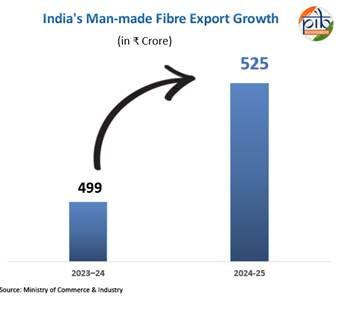
White Goods (ACs and LED Lights)
Launched in April 2021 with an outlay of ₹6,238 crore, the PLI scheme for white goods aims to transform India from an assembly hub to a high-value manufacturing base. It targets a jump in domestic value addition from just 20–25% to 75–80% by 2028–29. So far, incentives worth ₹281.4 crore have been disbursed, bolstering India’s push for energy-efficient, globally competitive appliances. India has begun local production of key components such as compressors, copper tubes, heat exchangers, motors, and control assemblies for air conditioners, as well as LED chip packaging, drivers, engines, light management systems, and metallized films for capacitors in the LED segment. This shift is significantly reducing import dependency and strengthening domestic manufacturing capabilities.
Performance So Far
By November 2024, the scheme had attracted committed investments of ₹1.61 lakh crore, surpassing expectations and demonstrating strong industry confidence in India’s policy direction. Actual investments realized have continued to rise, reaching approximately ₹1.76 lakh crore by March-2025, as more projects moved from approval to implementation stages.

The production impact has been remarkable. Total sales by PLI participants exceeded ₹16.5 lakh crore, reflecting impressive growth in key sectors such as electronics, pharmaceuticals, automotive, and textiles.
The PLI initiative has also emerged as a major job creator, generating over 12 lakh direct and indirect employment opportunities, while simultaneously fostering additional ecosystem development across Tier-2 and Tier-3 cities. Importantly, the scheme has catalyzed a fresh wave of FDI into the country, endorsing India as a preferred destination for high-value manufacturing in an evolving global scenario.
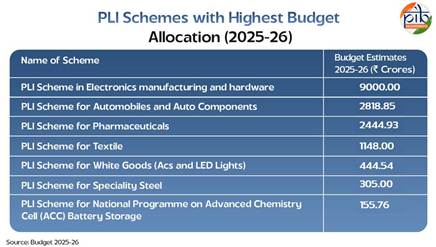
In a strong push to accelerate industrial growth, the Government has significantly increased budget allocations for key sectors under the PLI Scheme in 2025-26, reaffirming its commitment to strengthening domestic manufacturing.
The PLI scheme is expected to create a ripple effect across India’s MSME ecosystem. Anchor units in each sector are expected to develop new supplier and vendor networks throughout the value chain, with a significant share of these ancillary units emerging from the MSME sector.
The scheme has also led to the development of sector-specific clusters such as the display fabs and semiconductor parks in Gujarat, MMF clusters in Surat, and medical device parks in Andhra Pradesh and Tamil Nadu.
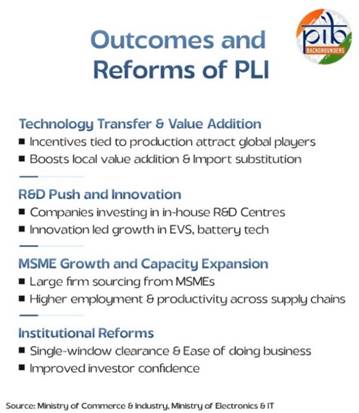
Conclusion
From once being heavily reliant on imports to now emerging as a serious contender in global manufacturing, India’s industrial journey has entered a transformative chapter and the PLI scheme is a major part of it. With investments exceeding ₹1.76 lakh crore and tangible gains in output, exports, and employment generation, PLI has evolved from a policy instrument to a catalyst of structural change.
By backing sunrise sectors, powering innovation, and anchoring global supply chains closer to home, the scheme is doing more than just reshaping factories, it’s reshaping the future of India’s economy. By supporting key industries, encouraging export-oriented production, and promoting the adoption of advanced technologies, the PLI schemes are strategically strengthening India's manufacturing base.
References:
Ministry of Commerce & Industry
PIB e-Booklet on PLI Scheme
PIB Backgrounder
PIB Press Release
Ministry of New and Renewable Energy
Ministry of Finance
Ministry of Labour & Employment
Ministry of Electronics & IT
Ministry of Civil Aviation
Ministry of Chemicals and Fertilizers
Invest India
Ministry of Food Processing Industries
Ministry of Textiles
Ministry of Heavy Industries
Expenditure Profile 2025-2026
Cabinet
NITI Aayog
India Brand Equity Foundation
Sansad
Click here to see in PDF
SK/M
(Backgrounder ID: 155082)
Visitor Counter : 13844
Provide suggestions / comments